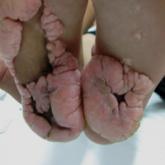Article
Delayed Diagnosis of Epidermal Nevus Syndrome Associated With Substantial Brain Malformations: A Case Report and Review of the Literature
Epidermal nevus syndrome (ENS) often describes a spectrum of different clinical and histologic subtypes of epidermal nevi as well as their genetic...


